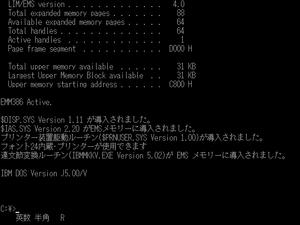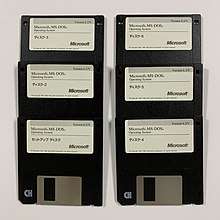DOS/V
DOS/V was a Japanese computing initiative starting in 1990 to allow DOS on IBM PC compatibles with VGA cards to handle double-byte (DBCS) Japanese text via software alone.[1] It was developed by IBM for its PS/55 machines (a localized version of the PS/2).[1] Kanji fonts and other locale information were stored on the hard disk rather than on special chips as in the preceding AX architecture. As with AX, its great value for the Japanese computing industry was in allowing compatibility with foreign software. This had not been possible under NEC's proprietary PC-98 system, which was the market leader before DOS/V emerged. DOS/V stands for "Disk Operating System/VGA" (not "version 5"; DOS/V came out at approximately the same time as DOS 5).
 | |
 Screenshot of IBM DOS J5.0/V | |
| Developer | IBM and Microsoft |
|---|---|
| Written in | Assembly language, C |
| OS family | DOS |
| Working state | No longer supported |
| Source model | Closed source |
| Initial release | November 1990 |
| Latest release | PC DOS J2000 / July 1998 |
| Available in | Japanese, Taiwanese, Chinese, Korean |
| Platforms | x86 |
| Kernel type | Monolithic kernel |
| Default user interface | Command-line interface |
| License | Commercial proprietary software |
The promotion of DOS/V was done by IBM and its consortium called PC Open Architecture Developers' Group (OADG).[1]
Digital Research released a Japanese DOS/V compatible version of DR DOS 6.0 in 1992.[2][3]
History
In early 1980s, IBM Japan released two x86-based personal computer lines for Asian-pacific region, IBM 5550 and IBM JX. The 5550 read Kanji fonts from the disk, and drew text as graphic characters on 1024×768 high resolution monitor. The JX extended IBM PCjr and IBM PC architecture. It supported English and Japanese version of PC DOS with 720×512 resolution monitor. Both machines couldn't break dominant NEC's PC-98 in consumer market in Japan. Because the 5550 was expensive, it was mostly sold for large enterprises who used IBM mainframes. The JX used 8088 processor instead of faster 8086 processor because IBM thought a consumer product of JX mustn't surpass a business-class 5550.[4] It damaged buyer's reputations whatever the actual speed was. In another point, a software company said IBM was uncooperative for developing JX software.[5] IBM Japan planned a 100% PC/XT compatible machine codenamed "JX2", but it was cancelled in 1986.[4][6]
Masahiko Hatori(羽鳥 正彦) was a developer of JX's DOS. In 1987, he started developing DOS/V during spare time at IBM Yamato Development Laboratory. In this era, Toshiba released J-3100 (a Japanese version of T3100 laptop) and Microsoft introduced the AX architecture. A few months later, IBM Japan released PS/55 Model 5535 which was a proprietary laptop using a special version of DOS. Hatori thought IBM needed to shift their own proprietary PC to IBM PC compatibles. His bosses, Tsutomu Maruyama(丸山 力) and Nobuo Mii, thought Japan's closed PC market needed to be changed and this attempt couldn't be done by IBM alone. In summer of 1989, they decided to carry out development of DOS/V, disclose the architecture of PS/55, and found the PC Open Architecture Developers' Group (OADG).[7]
The DOS/V development team designed the DOS/V to be simple for better scalability and compatibility with original PC DOS. They had difficulty reducing text drawing time. "A stopwatch was a necessity for DOS/V development", Hatori said.[8]
The first version of DOS/V was introduced on 11 October 1990, and shipped out in November 1990. The announcement letter said it was designed for low-end desktops and laptops of PS/55,[9] but users reported on BBS that they could run DOS/V on IBM PC clones.[10] The development team confirmed these comments and modified incompatibilities of DOS/V. It was a secret inside the company because it would prevent sales of PS/55 and meet with opposition. Hatori said,[7]
We hid the DOS/V run on other IBM compatible machines. The fact was that we developed it could run on Gateway's and any machines, but we had to keep the secret, not to spread it, because there are lots of enemies inside the company. In short, it was a double-edged sword. If the DOS/V run on such cheap compatible machines, conversely the 5550 series which had taken high profit up may not be sold. In fact, 80% of staff in Yamato office opposed it.
Maruyama and Mii had to convince IBM's branches to agree with the plan. In the beginning of December 1990, Maruyama went to IBM's Management Committee, and presented his plan "The low-end PC strategy in Japan". At the committee, a topic usually took 15 minutes, but his topic took an hour. The plan was finally approved by John Akers.[7]
After the committee, Microsoft Japan got a contract with IBM Japan to receive source code of DOS/V.[11] On 20 December 1990, IBM Japan announced they founded OADG and Microsoft would supply DOS/V for other PC manufacturers. From 1992 to 1994, most Japanese manufacturers begun selling IBM PC clones with DOS/V. Some global manufacturers entered into the Japanese market, Compaq in 1992 and Dell in 1993. Fujitsu released IBM PC clones (FMV series) on October 1993, and about 200,000 units were shipped in 1994.[12] Microsoft Japan released first retail versions of Windows (Windows 3.1) for both DOS/V and PC-98.
The DOS/V contributed the dawn of IBM PC clones in Japan, yet PC-98 had kept 50% of market share until 1996.[13] It was changed by the release of Windows 95.
Drivers
- $FONT.SYS – Font driver[14][15][16]
- $DISP.SYS – Display driver[17][15][16]
- $IAS.SYS – Input assist subsystem (IAS) with front end processor (FEP) support driver[15]
- $PRN.SYS – Printer driver[15]
- $PRNUSER.SYS – Printer driver[15]
- $PRNESCP.SYS – Printer driver for Epson ESC/P J84[15]
- $FONTX.SYS
- DSPXVBE.EXE
Versions
- IBM DOS/V Extension V1.0 (1993-01) includes V-Text support[18]
- IBM DOS/V Extension V2.0 "5605-PXB"[18]
PC DOS versions
PC DOS versions of DOS/V (J for Japanese, P for Chinese (PRC), T for Taiwanese, H for Korean):[19]
- IBM DOS J4.0/V "5605-PNA" (version 4.00 – 4.04 were not released for DOS/V)[20]
- IBM DOS J5.0/V "5605-PJA" (1991-10),[22][21][20] IBM DOS T5.0/V,[22] IBM DOS H5.0/V[22]
- PC DOS J6.1/V "5605-PTA" (1993-12),[22][21][20] PC DOS P6.1/V,[22] PC DOS T6.10/V
- PC DOS J6.3/V "5605-PDA" (1994-05)[22][21][20]
- PC DOS J7.0/V "5605-PPW" (1995-08),[21][19][20] PC DOS P7/V,[19] PC DOS T7/V,[19] PC DOS H7/V[19]
- PC DOS J2000/V "04L5610" (1998-07)[21][20]
MS-DOS versions
MS-DOS versions of DOS/V:
- Compaq MS-DOS 5.0/V (released before generic MS-DOS 5.0/V)
- Sony MS-DOS 5.0/V (contains Compaq MS-DOS 5.0/V)
- MS-DOS 5.0/V (generic MS-DOS 5.0/V)
- MS-DOS 6.0/V
- MS-DOS 6.2/V (1993-12)[20]
- MS-DOS 6.22/V (1994-08)
- Fujitsu Towns OS for FM Towns (only late issues had DOS/V compatibility added)
 Japanese MS-DOS 6.2/V floppy disks
Japanese MS-DOS 6.2/V floppy disks MS-DOS 6.2/V
MS-DOS 6.2/V
DR DOS versions
DR DOS versions of DOS/V:
See also
- Unicode
- List of DOS commands
- Kanji CP/M-86 (1984)
- DOS/V Power Report (A Japanese magazine on DOS/V)
Notes
- Japanese and Korean issues of the DR DOS ANSI.SYS driver contain support for a number of special arguments to switch to Japanese video modes and toggle between Korean and English input modes.
- A Japanese version of Novell NetWare Lite named "NetWare Lite 1.1J" existed for four Japanese platforms: DOS/V, Fujitsu FM-R, NEC PC-98/Epson PC and Toshiba J-3100. DOS/V-related updates were distributed by Novell as DOSV6.EXE, DOSV.EXE, TSBODI.LZH and were supported up to 1997.
- A Japanese version of Novell DOS 7 was announced and is referred to in various English documents, but was apparently never released.
- A Japanese version of Novell Personal NetWare 1.0 named "Personal NetWare J" existed for four Japanese platforms: DOS/V, Fujitsu FM-R, NEC PC-98/Epson PC and Toshiba J-3100, some of which were distributed by CONTEC. DOS/V-related updates were distributed by Novell as P10J0?.EXE (with ? replaced by 1 - 5), PNDOSV2.EXE, PNDOSV1.LZH and were supported up to 1995.
References
- Boyd, John (April 1997). "From Chaos to Competition - Japan's PC industry in transformation". Computing Japan Magazine. Archived from the original on 2017-01-16. Retrieved 2017-01-16.
- 土井, 誠二 (1992). DR DOS 6.0/V 試用レポート. ASCII (in Japanese). 16 (9): 238–240. ISSN 0386-5428.
- Wein, Josef "Joe" (2012) [2003]. "Resume: Joe Wein". Archived from the original on 2017-09-10. Retrieved 2017-09-10.
[…] [up to] 1992 Digital Research GmbH […] DR DOS 6.0 […] Japanese input support for Japanese version of DR DOS. […]
- "Special Interview キーマンが語る: 日本IBM情報システム(株) 竹村譲 氏、日本IBM(株) 羽鳥正彦 氏" [Special Interview : Key persons talks : IBM Japan Information System, Joe Takemura and IBM Japan, Masahiko Hatori]. ザ・ベーシック. 技術評論社. 120: 33–40. 1993.
- "戦略研究 パソコンビジネス―日本IBM". 日経パソコン. Nikkei McGraw-Hill. 1986-02-10: 180–184. ISSN 0287-9506.
- Hatori, Masahiko. "WingBird Lab. by M.hatori: DOS/V". Archived from the original on 2002-01-06. Retrieved 2018-06-21.
- "DOS/V 5周年 実録 日本アイ・ビー・エム物語" [5th Anniversary of DOS/V : Report : The story of IBM Japan]. ASAHIパソコン. Asahi Shimbun. 1995-04-01: 142–152. ISSN 0916-0302.
- Hatori, Masahiko. "DOS/V architecture" (in Japanese). Archived from the original on 1999-05-03. Retrieved 2018-06-25.
- IBM Japan (1990-10-11). PS/55に業界最高速モデル登場 [The industry's fastest model is now added on PS/55]. 情報科学 (in Japanese). ja:情報科学研究所 (published 1991). 27: 53–61. ISSN 0368-3354. Retrieved 2018-06-29.
- MIXハイライト : ibm.pc 会議 : PC/AT互換パソコンでDOS/Vが動いた [MIX highlights : ibm.pc forum : I found the DOS/V could run on PC/AT compatibles]. 日経バイト (in Japanese). Nikkei Business Publications: 326–329. January 1991. ISSN 0289-6508. Retrieved 2020-03-06.
- Furukawa, Susumu (2015). 僕が伝えたかったこと、古川享のパソコン秘史. Japan: Impress R&D. ISBN 978-4-8443-9700-7.
- "戦略研究 富士通". 日経パソコン. Nikkei Business Publications. 1994-10-10: 166–173. ISSN 0287-9506.
- "96年度パソコン国内出荷台数、前年度比29.7%増―マルチメディア総研". Nikkei Sangyo Shimbun. 1997-04-24. p. 9.
- "$FONT.SYS". PC Users' Guide Forums (FPCU). Retrieved 2017-01-15.
- Myers, Steven; Smith, Greg (March 1995). "DOS/V: The Soft(ware) Solution to Hard(ware) Problems". Computing Japan Magazine. Archived from the original on 2017-01-15. Retrieved 2017-01-15.
- Cha. N. (2012-10-21). "DOS/V - FONTX - Electronics Projects". Archived from the original on 2017-01-15. Retrieved 2017-01-15.
- "$DISP.SYS". PC Users' Guide Forums (FPCU). Retrieved 2017-01-15.
- "V-Text-24" (in Japanese). 2011-10-13. Retrieved 2017-01-16.
- "SurePOS 100 IBM 4613 Point of Sale Terminal Technical Reference" (PDF). 1.0. IBM Corporation. 2007-12-31 [2001]. Archived from the original (PDF) on 2016-08-06. Retrieved 2017-01-16.
- "Timeline of DOS/V versions" (in Japanese). 2014-11-28. Retrieved 2020-03-06.
- akm (2013) [2007]. "What's DOS/V". Retrieved 2020-03-06.
- "IBM AS/400 Client Access Branches into Two New Families -- AS/400 Client Access Family for Windows and AS/400 Client Access Family Version 4 Release 1 - Software Announcement". IBM. 1997-08-19. Announcement Letter Number: 297-302. Archived from the original on 2017-01-16. Retrieved 2017-01-16.
- Tam, Roy; Elliott, John C. (2014-01-12). "DR DOS 6.0/V". Archived from the original on 2018-09-03. Retrieved 2017-01-16. (NB. Has screenshots of a DBCS-enabled version of ViewMAX 2 running on DR DOS 6.0/V and a hex dump of the corresponding DRFONT database SCREENHZ.FNT for its $FONT.SYS.
- "Minimum Patch List (Japanese)" (in Japanese and English). Novell. 2006-01-19. Archived from the original on 2017-01-16. Retrieved 2017-01-16.
- Paul, Matthias R. (1997-07-30). NWDOS-TIPs — Tips & Tricks rund um Novell DOS 7, mit Blick auf undokumentierte Details, Bugs und Workarounds. MPDOSTIP. Release 157 (in German) (3 ed.). Archived from the original on 2017-09-10. Retrieved 2012-01-11. (NB. NWDOSTIP.TXT is a comprehensive work on Novell DOS 7 and OpenDOS 7.01, including the description of many undocumented features and internals. It is part of the author's yet larger MPDOSTIP.ZIP collection maintained up to 2001 and distributed on many sites at the time. The provided link points to a HTML-converted older version of the NWDOSTIP.TXT file.)
- Izumi, Yu, ed. (2006-06-11) [2001-03-03]. DR DOS 7.0x/V 非公式インストールマニュアル - 管理人関係リンク [DR DOS 7.0x/V - Unofficial installation, manual administration, links]. 4.7.4 (in Japanese). Japanese DR DOS User's Group (JDUG). Archived from the original on 2018-09-16. Retrieved 2020-03-06.
Further reading
- Adachi, Tsuyoshi (1994). DOS/V Technical Reference Manual. Softbank Books.
- Tsuchiya, Masaru (1994). PC DOS 6/V Handbook. Natsumesha, Inc.
- Compaq Seran Kikaku Division (1993). DOS/V Pasokon. Seitousha, Inc.